Todmorden, West Riding of Yorkshire (originally Lancashire)
Up to 1834
A parliamentary report of 1777 recorded local workhouses in operation at Errinden [Erringden] (for up to 20 inmates), Heptonstall (24), Langfield (14), and Stansfield (25).
Langfield's workhouse was located at Croft Carr. The presence of a "rope walk" at the east of the building suggests that rope-making provided work for the inmates.
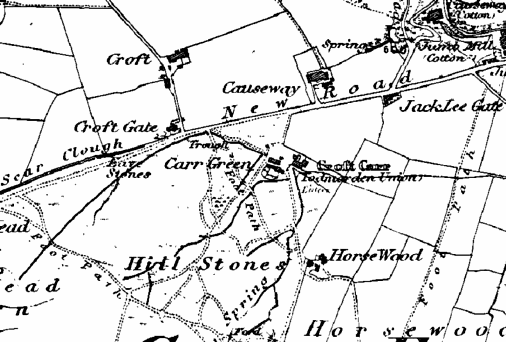
Langfield Croft Carr workhouse site, 1853
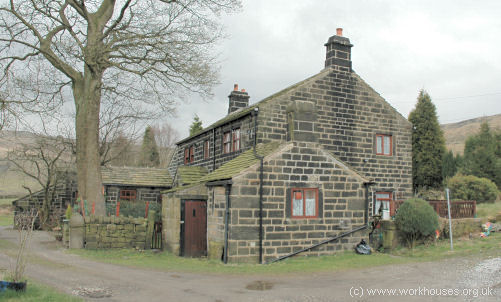
Langfield former Croft Carr workhouse from the north-west, 2006.
Stansfield's workhouse was at Lane Head, to the east of Blackshaw Head.
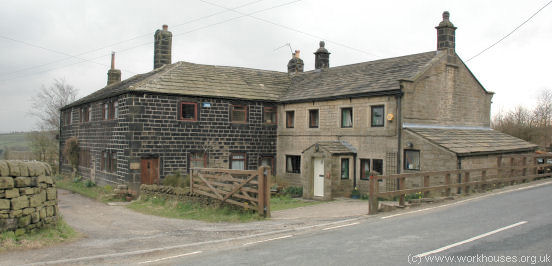
Stansfield's former Blackshaw Head workhouse from the north-east, 2006.
Wadsworth operated a workhouse at Spink Hill in what is now a farmhouse.
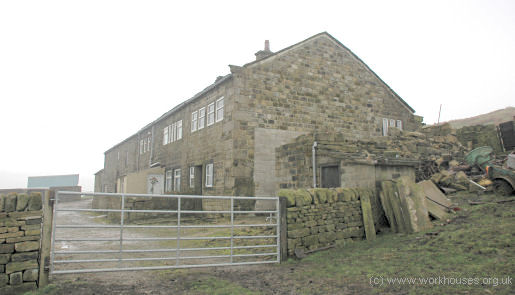
Wadsworth's Spink Hill workhouse from the south-east, 2006.
Todmorden and Walsden set up a workhouse alongside the canal at Gauxholme in 1801 in a house rented from John Sutcliffe and John Shackleton for 18 guineas a year. The parish overseers purchased 10 cast iron beds each with a straw mattress, 2 blankets, one sheet, one bolster and one woollen quilt.
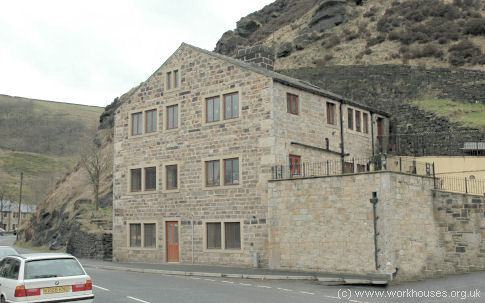
Todmorden former Gauxholme workhouse, 2006.
Heptonstall historian, the late Colin Spencer, researched the Heptonstall workhouse which opened in 1754 on a rented farm on Edge Lane.
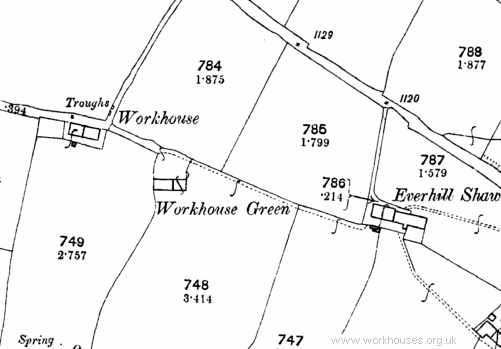
Heptonstall Edge Lane site, 1894
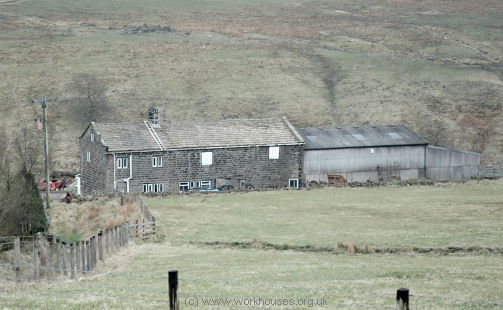
Heptonstall Edge Lane workhouse from the north-west, 2006.
The township overseers treated the farm as a working farm. At about 1100 feet above sea level, the only grain crop that could be grown there was oats. According to local records, the ground was prepared for sowing the following spring:
"March 1st Pd. John Pickles and Thomas Whitley for Graveing 5 Daywork: £2-0-0"
"Graving" was a two man operation of turning over the soil by hand, one man cutting the turf and the other turning it over; a "daywork" was an area of 3136 square yards, about two thirds of an acre, and the wages at the time were about eight shillings a week, so it took these two men about two and a half weeks to turn over the five daywork of land. John Pickles was also paid "for Gaten out muck to the Corne". Finally, the seed corn was bought:
| 29 April Pd. Jas. Walton for 18 strikes of Seed Corn | 0-17-0 |
| Pd. Will Sutcliffe for 2 Load of Seed Corn | 1-10-0 |
(Later references are to "Holland Oats". A "strike" or "stroke" was a measure equal to four gallons or half a bushel.)
The overseers also fitted out the interior for the expected inmates, for example with "One duzan of spoons" together with 15 basins and 13 mess pots, suggesting a household of about a dozen inmates. They were well looked after and were probably better off than most of the families in the village, with meal and coal arriving regularly, and luxuries such as tobacco being bought not infrequently. The shopping list for Christmas 1755 was:
| For a Cows Head for Workhouse | 1 2 |
| A Barrel for the Workhouse | 1 8 |
| 3 Loads of Coal for the Workhouse | 2 6 |
| For 3 Treacle lb | 6½ |
| For 3 pecks of Malt and Hops | 3 - 0 |
The list for 1762 included:
| Apples, treacle, sugar, Currans, etc, etc | 2 6 |
| Clove, pepr, seeds, etc | 8½ |
| Matts and Bacco for Workhouse | 3 0½ |
| 24 lb Sope and Hops | 3 0 |
| 12 lb Treacle | 2 - 4 |
Thomas Sunderland was appointed Workhouse Master at £20 a year and supervised the farming and harvesting. The Heptonstall corn was taken down to the mill in Hebden Bridge for drying and grinding. The workhouse had only two spinning wheels and some spindles, suggesting that very little indoor work was expected from the inmates. It was intended to be a self-supporting institution but the income, chiefly from spinning and farm produce, was always well below the expenses which included the heavy burdens of the farm rent and the master's wage. In 1780-81 the total income was just over £16 to set against expenses of nearly £75. In 1781 82 the deficit was £48, and when the cost of the workhouse reached £105 in 1783-84 the principal inhabitants decided that enough was enough. After a town meeting, it was decided that the township's paupers should be "farmed" by a contractor. Ambrose Gill, a weaver, undertook to be responsible for the feeding and clothing of the workhouse inhabitants "at the sum of eight Shillings a Piece each Person for a Calendar Month". By 1800 the total cost of the workhouse was only £6-13-7½ with a few short stays only.
After 1810, the Heptonstall workhouse moved to Popples Bottom, Slack.
A parliamentary report in 1834 recorded the workhouse populations in a number of Todmorden townships:
| Workhouse | Inmates |
|---|---|
| Erringden | 4 inmates: 2 males and 2 females aged from 18 to 65. |
| Heptonstall (temporary workhouse) | About 8 inmates. |
| Langfield | 8 inmates: 5 males (aged 52, 14, 10, 8, 7) and 3 females (aged 54, 40, 7). |
| Stansfield | 15 inmates: 3 males (aged 7, 4, 1) and 12 females (aged 89, 85, 67, 54, 42, 41, 40, 29, 23, 8, 9, 4). |
| Wadsworth | 21 inmates |
After 1834
The Todmorden Poor Law Union was officially formed on 15th February 1837. Its operation was overseen by an elected Board of Guardians, 18 in number, representing its 6 constituent parishes and townships as listed below (figures in brackets indicate numbers of Guardians if more than one):
County of Lancaster:
Todmorden and Walsden (4).
County of York - West Riding:
Erringden (2), Heptonstall (3), Langfield (2), Stansfield (4), Wadsworth (3).
Later Additions (all from 1894): Blackshaw, Hebden Bridge, Mytholmroyd.
The population falling within the Union at the 1831 census had been 23,397 with parishes and townships ranging in size from Erringden (population 1,933) to Todmorden (6,054). The Todmorden Union was originally assigned to the county of Lancashire for statistical purposes but from the 1850s was placed in Yorkshire.
Todmorden Poor Law Union was the one of the most vehement in its opposition to the 1834 Poor Law Amendment Act. Its member parishes had resisted forming a Poor Law Union but eventually gave way. However, opposition to the building of a new workhouse, led by John Fielden, held firm with a refusal to pay the poor rates. A riot took place with the Chairman of the Board of Guardians being attacked. In 1844 the Union was, exceptionally, given leave to abandon the requirement to provide a workhouse. An 1847 local directory records the union as using three small buildings at Gauxholme, Stansfield and Wadsworth as workhouse accommodation.
Finally, in 1876, under continuing threat of the union being dissolved, Todmorden became the last union in England to provide a workhouse when it began to erect one at Lee Bottom near Mankinholes. Ironically, the site on which it was built was on an estate known as Beggarington. The first inmates were admitted at the end of September, 1878, with the first master and matron being Mr and Mrs Gent from Eccles.. The initial capacity of the workhouse was 100 but in 1890 the buildings were expanded to accommodate 250.
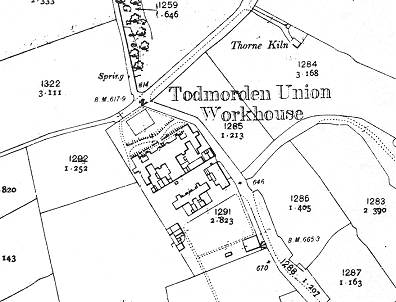
Todmorden workhouse site, 1905
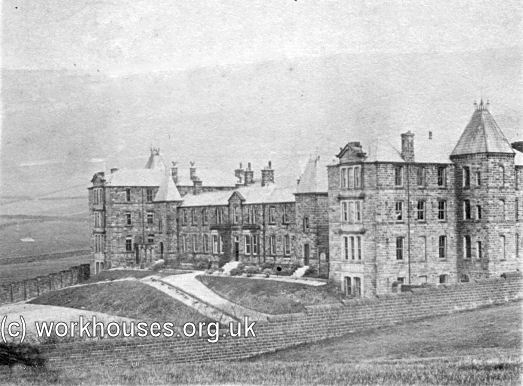
Todmorden workhouse from the west, c.1902.
© Peter Higginbotham.
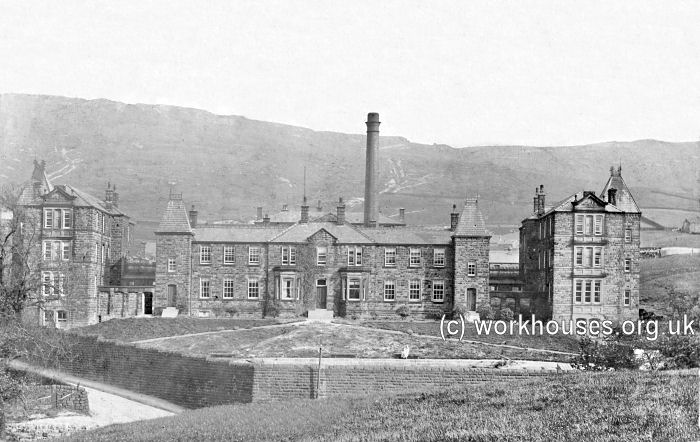
Todmorden workhouse from the north-west, c.1906.
© Peter Higginbotham.
The picture below, which dates from around 1897, shows the front entrance to the workhouse with the master and matron and what are presumably other workhouse staff.
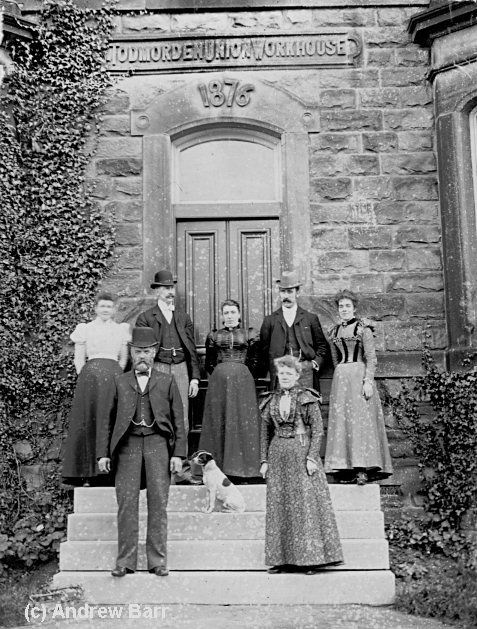
Todmorden workhouse entrance, c.1897.
© Andrew Barr.
In 1930, the workhouse became a Public Assistance Institution serving the new Calder "Guardian's Area". At that time, it had accommodation for 293, including 69 in the casual wards (60 male places and 9 female). A council architect's report on the buildings noted that they were lighted throughout by gas. The water supply was from a small reservoir in the grounds and was not filtered in any way. Hot water was available in all parts, but only a limited amount of central heating was installed. In the casual ward, there were eight cells for females, twenty cells for males each equipped for corn-grinding work, and a tramp major's room.
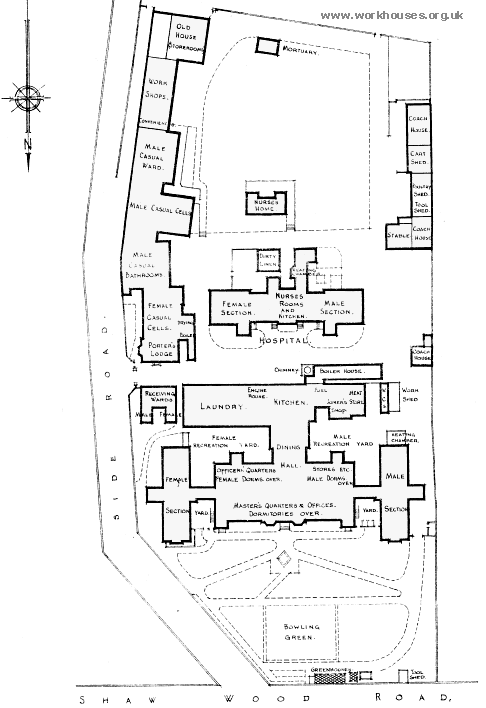
Todmorden workhouse site, 1930
The institution later became Stansfield View Hospital and after 1948 provided care for the mentally handicapped. The vagrants' wards were closed in 1950. The buildings were demolished in 1996 and the site cleared.
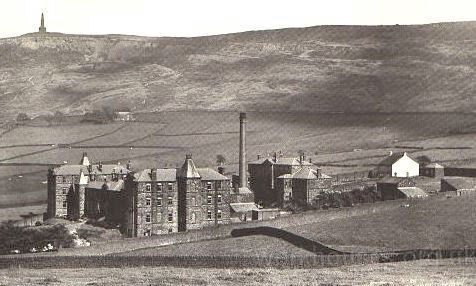
Todmorden workhouse from the west, c.1906.
Cottage Home
The Todmorden Union operated a children's home at Mankinholes Hall on Mankinholes Bank, now Mankinholes Youth Hostel. The home could accommodate 25 children.
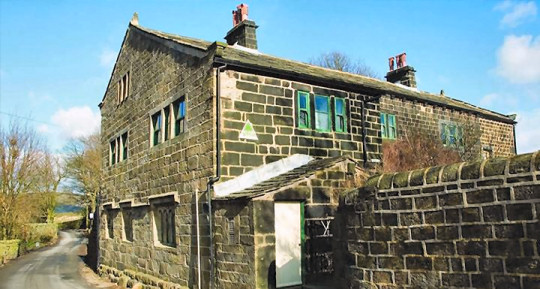
Former Todmorden Union children's home, Mankinholes.
Staff
Inmates
Records
Note: many repositories impose a closure period of up to 100 years for records identifying individuals. Before travelling a long distance, always check that the records you want to consult will be available.
- West Yorkshire Archive Service (Calderdale Office), Central Library, Northgate House, Northgate, Halifax HX1 1UN. Holdings: Minutes and reports (1911-66); Accounts 1940-8); Inventories (1929-48); Hospital farm records (1924-16); Patients' creed registers (c.1912-54); Registers of patients and paupers (1882-1943); Admission and discharge register (1879-80); Admission records (1948-65); Infirmary admission and discharge register (1879-1954); Infirmary deaths register (1914-36); Indoor reflief lists (1922-30); etc.
Bibliography
- Todmorden Workhouse by Anthony Chadwick (Ripon Museum Trust leaflet, 1996)
- White, W. (1847) Directory and Topography of Leeds, Bradford, Halifax, Huddersfield, Wakefield, and the whole of the clothing districts of the West Riding of Yorkshire
Links
- Ripon Workhouse Museum and Garden, Sharow View, Allhallowgate, Ripon HG4 1LE.
- Gauxholme Workhouse
- Poor relief in Todmorden and Walsden
Acknowledgment
- Thanks to Kathy Tomlinson Andrew Barr for help with material for this page, and to Diana Monahan for very kindly contributing Colin Spencer's researches.
Unless otherwise indicated, this page () is copyright Peter Higginbotham. Contents may not be reproduced without permission.


